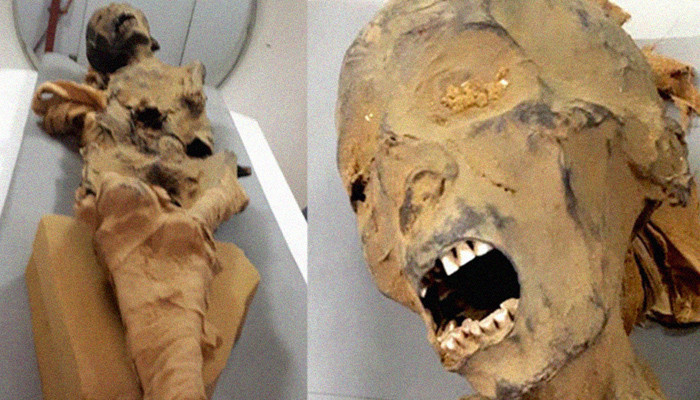CT scan reveals the story behind the 'mummy of the screaming woman' from Deir El-Bahari’s Royal Cachette
 A study carried out by renowned Egyptologist Zahi Hawass and Sahar Saleem, professor of radiology at Cairo University who specialises in scanning mummies, has solved the mystery of ''the mummy of the screaming woman'' from the Royal Cachette in Deir El-Bahari. Hawass told Ahram Online that the CT study and analysis conducted on the mummy revealed that severe atherosclerosis of the coronary arteries had led to sudden death of the Egyptian princess from a heart attack. He said that the ancient Egyptian embalming process had preserved the posture of the princess at the moment of death. Hawass explains that the story began in 1881, when the Royal Cachette of Deir El-Bahari was discovered in Luxor. The site is where the priests of the 21st and 22nd dynasties hid royal members from previous dynasties, to protect them from grave robbers. The Royal Cachette contained the ''mummy of the screaming man.'' Recent studies using CT scans and DNA, done by the scientific team of the Egyptian Mummy Project, proved that the mummy is that of Pentawere, son of King Ramses III, who was forced to commit suicide by hanging as a punishment for his involvement in the killing of his father, in what is known as the Harem Conspiracy. The murderous son was punished by not being embalmed; his body was wrapped in a sheep skin, which indicates that he was considered ''unclean'' and that his fate was to be punished in the afterlife. Other mummies were wrapped in white linen and carefully mummified. The same Royal Cachette in Deir El-Bahari also contained a mummy of a woman showing signs of terror, pain and opened mouth as if screaming, hence known as ''the mummy of the screaming woman.'' To solve this mystery, Hawass and Saleem carried out a study and examined the mummy with a CT machine located at the Egyptian Museum. Writings in the ancient hieratic Egyptian language on the linen wraps of the mummy read: ''The royal daughter, the royal sister of Meret Amon.'' However, the mummy was considered unknown and was thus designated the ''mummy of the unknown woman A'' as there were many princesses with the same name, for example Meret Amun, daughter of King Seqenenre of the end of the seventeenth dynasty (1558-1553 BC), and also Meret Amun, daughter of King Ramses II (1279-1213 BC) from the nineteenth dynasty. The results of CT scan indicates that the ''mummy of the screaming woman'' is a woman who died in her sixth decade. Unlike Pentawere, the body of the woman received a good mummification treatment. Consequently, it is obvious that the circumstances of her death are different. Hawass said that the CT results indicate that the mummy suffered from severe degree of atherosclerosis, which affected many arteries of the body. He explains that atherosclerosis is a degenerative disease that progressively affects the arterial wall, leading to a narrowing of the cavity and blockage of the vessel. The CT scan showed that she suffered from atherosclerosis of the right and left coronary arteries, neck arteries, abdominal aorta and iliac arteries, as well as the arteries of the lower extremities. Cardiac diseases, especially coronary artery disease, are the leading cause of sudden death in adults in the modern period. It seems that the ''screaming woman'' died suddenly while in her current body posture, with flexed crossed legs. Consequent to death, her head was tilted to the right side and her jaw dropped. ''We assume that the dead body of ‘the screaming woman’ might not have been discovered until hours later, enough to develop rigor mortis,'' said Hawass. ''We assume that the embalmers likely mummified the contracted body of the ‘screaming woman’ before it decomposed or relaxed. The embalmers were thus unable to secure the mouth closed or put the contracted body in the state of lying down, as was usual with the other mummies, thus preserving her facial expression and posture at the time of death,'' he said. |

Japan Unveils Human Washing Machine, Now You Can Get Washed Like Laundry (video)
86501.12.2025, 20:45
Chinese humanoid robot sets Guinness World Record with 106-km inter-city walk (video)
72924.11.2025, 16:30
Musk։ Optimus will be able to eliminate poverty and provide everyone with a universal high income (video)
74223.11.2025, 12:45
AGMI researchers expose the hidden role of female perpetrators in the Armenian Genocide (photo)
74913.11.2025, 21:15
LVM3-M5 mission successfully launches CMS-03 satellite (video)
107702.11.2025, 21:17
Google разработала квантовый алгоритм, работающий в 13 тыс. раз быстрее алгоритма суперкомпьютеров
144122.10.2025, 23:44
